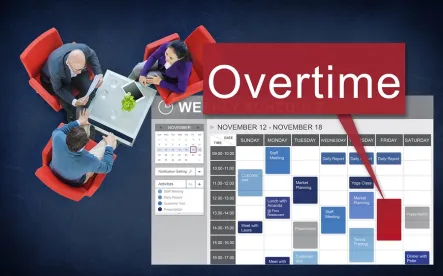On May 18, 2016, the U.S. Department of Labor (“DOL”) announced the publication of a final rule that amends the “white collar” overtime exemptions to significantly increase the number of employees eligible for overtime pay. The final rule will go into effect on December 1, 2016.
Background
Amendments to the white-collar overtime exemptions have been in the works for some time. In March 2014, President Obama directed the DOL to “enhance” the white-collar exemptions. Last summer, the DOL issued its Notice of Proposed Rulemaking (“NPRM”), in which it proposed more than doubling the salary threshold for the executive, administrative, and professional exemptions, as well as significantly increasing the threshold for the highly compensated employee exemption.
Specifically, the NPRM proposed increasing the salary threshold for the executive, administrative, and professional exemptions from $455 per week to $970 per week—or from $23,660 per year to $50,440 per year. And it proposed increasing the salary threshold for the highly compensated employee exemption from $100,000 to $122,148 annually.
Nearly a year after issuing its NPRM and having received almost 300,000 comments regarding the proposed changes, the DOL announced the publication of the final rule. While the final rule does not increase the salary thresholds for the executive, administrative, and professional exemptions to the levels proposed in the NPRM, it nevertheless significantly increases those thresholds. And the final rule includes an even higher threshold for the highly compensated employees than that proposed last summer.
As a result of the final rule, employers throughout the country will need to confirm whether the compensation for employees currently treated as exempt would satisfy the new thresholds. If not, employers would need to determine whether to increase the compensation for those individuals to satisfy the new thresholds, or to convert those employees to non-exempt status such that they become eligible for overtime compensation.
What Is New
The final rule provides for the following changes to the executive, administrative, and professional exemptions:
-
The salary threshold for the executive, administrative, and professional exemptions will increase from $23,660 ($455 per week) to $47,476 ($913 per week), which represents the 40th percentile of full-time salaried workers in the lowest-wage census region (currently the South). This threshold is approximately $3,000 less per year than that proposed last summer in the NPRM.
-
The total annual compensation requirement for “highly compensated employees” subject to a minimal duties test will increase from the current level of $100,000 to $134,004, which represents the 90th percentile of full-time salaried workers nationally. This threshold is approximately $12,000 more per year than that proposed last summer in the NPRM.
-
The salary threshold for the executive, administrative, professional, and highly compensated employee exemptions will be automatically updated every three years to maintain the standard salary level at the 40th percentile of full-time salaried workers in the lowest-wage census region to “ensure that they continue to provide useful and effective tests for exemption.”
-
The salary basis test will be amended to allow employers to use non-discretionary bonuses and incentive payments, such as commissions, to satisfy up to 10 percent of the salary threshold.
What This Means
While it is certainly good news for employers that the duties tests for the various exemptions will not be augmented, the significant increase to the salary threshold is expected to extend the right to overtime pay to an estimated 4.2 million workers who are currently exempt. This change will not only affect labor costs but also require employers to rethink the current structures and efficiencies of their workforces, including assessing how the reclassification of workers from exempt to non-exempt will affect their fundamental business models. In addition, to the extent exempt employees are reclassified as non-exempt, employers will have to consider implementing policies and procedures to both comply with overtime laws and control overtime worked, such as proscription against off-the-clock work and proper maintenance of accurate record-keeping.
The apparent trade-off for scaling back the salary threshold from the proposed $50,440 to $47,476 for the executive, administrative, and professional exemptions is the increase in the highly compensated employee salary threshold from the proposed $122,148 to $134,004 announced in the final rule. That, of course, is a substantial increase to the current $100,000 threshold and will likely result in employers relying less than they had previously on this exemption.
The permitted use of non-discretionary bonuses and incentive payments, such as commissions, to satisfy up to 10 percent of the salary threshold may help soften the impact of the increase to the salary threshold. Employers should proceed carefully, however, if they wish to take advantage of that provision. For example, employers should make sure that the 10 percent maximum allowance is not exceeded, which could otherwise lead to misclassification claims. Also, employers should be mindful of maintaining a proper distinction between discretionary and non-discretionary bonuses and only attribute the latter to satisfy the salary threshold.
Resistance to the final rule can be expected. There is little doubt that the DOL modified its proposed salary threshold increase of $50,440 to $47,476 in response to nearly 300,000 comments, many of which were from employers and advocacy groups providing thoughtful commentary on the practical issues and repercussions of implementing such a significant increase to the salary threshold. Because of the severity of the final rule, a Congressional challenge may be in the offing. Subject to the Congressional Review Act, the final rule will be scrutinized by the next Congress to be seated in 2017.
What Employers Should Do Now
With the benefit of more than six months until the final rule takes effect, employers should not delay in auditing their workforces to identify employees currently treated as exempt who will not meet the new salary threshold. For such workers, employers will need to determine whether to increase workers’ salaries or convert them to non-exempt.
If an employee’s salary need only be increased slightly to satisfy the final rule, it may be an easy decision for the employer simply to provide the employee with that salary increase. So, too, might an employer have an easy decision to reclassify an employee as non-exempt if it would have to provide a substantial salary increase to meet the new threshold.
Many difficult decisions, however, will likely need to be made by employers. Converting employees from exempt to non-exempt implicates a number of other issues that employers should carefully analyze, such as estimating how much overtime an individual is expected to work to determine what an employee’s new hourly rate will be to ensure compliance with the overtime laws.




 />i
/>i
